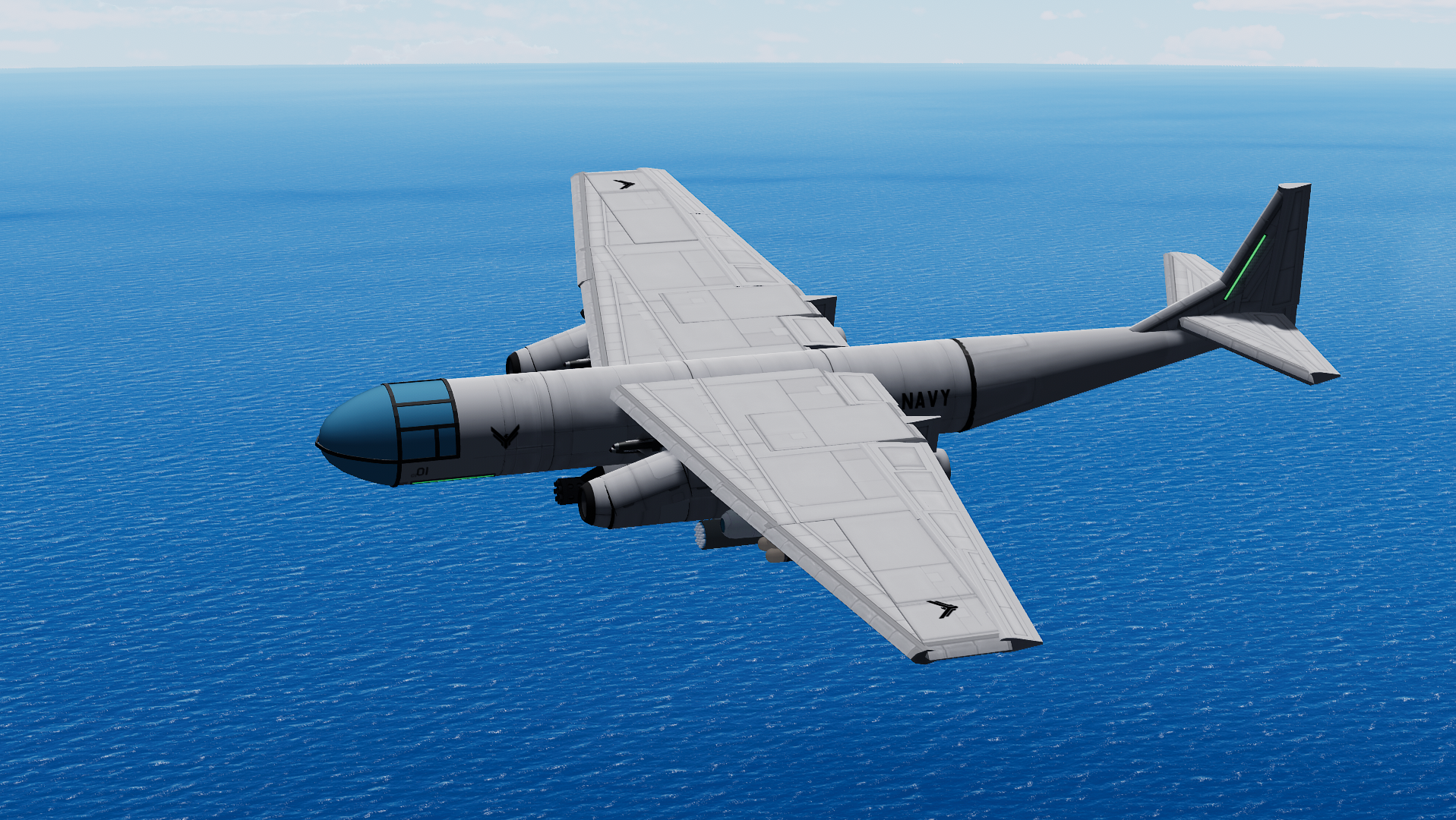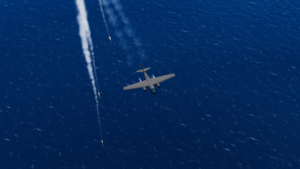Northwind Aerospace NW-26 Squall: Difference between revisions
| Line 41: | Line 41: | ||
=== Early Service === |
=== Early Service === |
||
| − | Entering service in the late 2160s/Early 2170s, the situation of the Belkan Civil War remained in a stalemate, with the forces of [[House Atreus]], [[House Traakand]], and [[House Rison]] in the north struggling to break through the lines of [[House Dreimor]] and [[House Artieti]] of the south. With the arrival of the NW-26 alongside further production of Z-90 and NW-25 fights [[Royal Coalition of Central Veiid]] forces began to see progress during large scale campaigns such as [[Operation Hyperion]] and [[Operation Highwater]]. Praised by soldiers and commanders in the Coalition Army |
+ | Entering service in the late 2160s/Early 2170s, the situation of the Belkan Civil War remained in a stalemate, with the forces of [[House Atreus]], [[House Traakand]], and [[House Rison]] in the north struggling to break through the lines of [[House Dreimor]] and [[House Artieti]] of the south. With the arrival of the NW-26 alongside further production of Z-90 and NW-25 fights [[Royal Coalition of Central Veiid]] forces began to see progress during large scale campaigns such as [[Operation Hyperion]] and [[Operation Highwater]]. Praised by soldiers and commanders in the Coalition Army due to the determination of Squall crew members and the "Trust the troops can put in the birds." Leading to NW-26's being deployed in higher numbers not just because of their effectiveness, but also their psychological effect on both their enemies, and friendly forces. |
==== Operation Leviathan ==== |
==== Operation Leviathan ==== |
||
| Line 52: | Line 52: | ||
=== Mid-War Service === |
=== Mid-War Service === |
||
[[File:Screenshot (940).png|thumb|A NW-26A testing the employment of three SRS-2003 "Shadow Realm" cruise missiles for use on the NW-26B, c. 2171.]] |
[[File:Screenshot (940).png|thumb|A NW-26A testing the employment of three SRS-2003 "Shadow Realm" cruise missiles for use on the NW-26B, c. 2171.]] |
||
| − | Following the success of [[Operation Libero]] in Late 2172 and the successful capturing of [[Servagrad]], Dreimor, the NW-26 became less of a frontline CAS airframe, and returned to a traditional bomber role, however with the introduction of the NW-26B, the Squall became a "Missile Truck" carrying even larger cruise missiles and more ordinance to support ground forces when placed in a CAS role. However, some NW-26A squadrons, lacking the larger -B variant remained in a CAS role, flying alongside [[Atreian Home Air Force]] (AHAF) [[Dingo Multirole Transport Aircraft|Dingo]] III's and Air Force Z-90's. The GAU-8 Avenger typically found on CAS-Equipped NW-26's was documented by Army combat units to provide a "Noticeable" morale boost by the sound of the gun firing alongside the reputation of |
+ | Following the success of [[Operation Libero]] in Late 2172 and the successful capturing of [[Servagrad]], Dreimor, the NW-26 became less of a frontline CAS airframe, and returned to a traditional bomber role, however with the introduction of the NW-26B, the Squall became a "Missile Truck" carrying even larger cruise missiles and more ordinance to support ground forces when placed in a CAS role. However, some NW-26A squadrons, lacking the larger -B variant remained in a CAS role, flying alongside [[Atreian Home Air Force]] (AHAF) [[Dingo Multirole Transport Aircraft|Dingo]] III's and Air Force Z-90's. The GAU-8 Avenger typically found on CAS-Equipped NW-26's was documented by Army combat units to provide a "Noticeable" morale boost by the sound of the gun firing alongside the reputation of NW-26 crewmen and women as fearless |
Revision as of 02:41, 17 October 2024
The Northwind Aerospace NW-26 "Squall" is a Multi-Role Light Bomber designed by Northwind Aerospace and used by the Atreian Navy, and Atreian Air Force.
|
NW-26 Squall
Northwind Aerospace NW-26 Squall Light Bomber
|
|||||
|---|---|---|---|---|---|
| Subsonic Multirole Light Bomber | |||||
 |
|||||
| An Atreian Navy NW-26 on a training exercise in the Tau Sea, c. 2189 | |||||
| National Origin | Atreus | ||||
| Production History | |||||
| Designed | |||||
| 2166 - 2168 | |||||
| Produced | |||||
| 2168 - N/A | |||||
| Designer | Northwind Aerospace | ||||
| Unit Cost | 28,696(√) | ||||
| Number Built | 85 | ||||
| Service History | |||||
| In Service | |||||
| 2168 - N/A | |||||
| Used By | Atreian Air Force, Atreian Navy | ||||
| Aircraft Characteristics | |||||
| Dry Mass | 17,508kg | ||||
| Length | 13.7 m | ||||
| Width | 15.4 m | ||||
| Height | 4.3 m | ||||
| Propulsion | 2 x J-28 "Tiger" Afterburning Turbofans | ||||
| Maximum Velocity | 138m/s (Dry) 196m/s (Wet) | ||||
| Crew | 2-4 | ||||
| Variants | NW-26B, NW-26C | ||||
Development
Origins
Designed for a need for a bomber smaller than the Zokesian Z-5 Naval Bomber, and larger than Fighter-Bombers such as the Z-90, or NW-25 Cheetah not requiring the supersonic speeds needed of such aircraft the Atreian Air Force initially sent out bids for a new light bomber in the mid 2160s following the outbreak of the Belkan Civil War and the deficit of aircraft. Two designs from Northwind and Odyssey Industries were submitted however due to the lack of progress on the design from Odyssey, the Atreian Air Force granted Northwind the contract for the new light bomber to Northwind's NW-26.
Early Prototypes
With the first prototype named "P1" finished in March 2167, problems were noticed immediately including poor weight distribution causing the P1 to be nose-heavy and somewhat difficult to fly. This issue alongside the weak rear landing gear causing the first accident in the NW-26's career.
On January 26th, 2168, a test flight evaluating the NW-26's performance at high AOAs and G-Forces nearly ended in disaster as Air Force Test Pilot William Virfurt and Flight Engineer Robert Jacobson descended to land at Victory AFB in Rison, Atreus. As the aircraft landed on runway 35R the back left landing gear of the aircraft collapsed upon braking potentially caused by the winter runway conditions alongside the already weak landing gear. This caused the aircraft to enter an uncontrolled spin leading it off the runway, leading to the flight engineer ejecting causing the pilot to eject automatically, both coming out of the crash with minor injuries. The airframe of P1 is now displayed in the Air and Aerospace Museum in Kolburg.
Following the accident, Northwind was able to find the fault in the gear, also taking the opportunity to adjust the weight and balance of the airframe to be easier to fly, and as a result have a lower accident rate.
Design
The NW-26 prioritized avionics and weaponry over flight performance, mounting 2 variants of the APG-77 including the v1 variant as the backbone of the sensor suite, allowing the aircraft to detect vehicles commonly outside of the range of its weapons, leading to the NW-26 primarily focusing on its ability to carry large cruise missiles instead of its original role of Close Air Support (CAS).
One of the standout features of the NW-26 is its semi-spherical cockpit, allowing unrivaled visibility above and below the aircraft, praised by its crews, especially by pilots for its ease of use and an ability for new pilots to feel confident flying in training and exercises due to the fact that it is not required to "guesstimate" the location of runways or carrier decks that can be observed on larger airframes.
However, the most commonly produced variant of the NW-26, the NW-26A only features two, J-28 "Tiger" Afterburning Turbofans similar to engines mounted on fighters such as the Z-55 Light Fighter. Crews of the NW-26 have observed to be dissatisfied with the thrust produced, and how dramatically the airframe loses performance when mounted with even medium amounts of ordinance. This flaw was considered the most common loss of airframes during the Belkan Civil War.
Operational History
Early Service
Entering service in the late 2160s/Early 2170s, the situation of the Belkan Civil War remained in a stalemate, with the forces of House Atreus, House Traakand, and House Rison in the north struggling to break through the lines of House Dreimor and House Artieti of the south. With the arrival of the NW-26 alongside further production of Z-90 and NW-25 fights Royal Coalition of Central Veiid forces began to see progress during large scale campaigns such as Operation Hyperion and Operation Highwater. Praised by soldiers and commanders in the Coalition Army due to the determination of Squall crew members and the "Trust the troops can put in the birds." Leading to NW-26's being deployed in higher numbers not just because of their effectiveness, but also their psychological effect on both their enemies, and friendly forces.
Operation Leviathan
The NW-26 saw the most use during Operation Leviathan taking place on the night of October 12th, 2170. Considered too dangerous to to use the expensive Z-5 which was in limited quantity and too valuable to lose on a high-risk mission the NW-26 was considered the optimal aircraft to carry Anti-Radiation Missiles, and Anti-Ship Missiles to take out the recently captured BFS Eminent Domain II and its escorts under Dremorian Control due to its high supply and low cost compared to other platforms.
Launching alongside F-52 Kargadan's from ANS Ella II and OD-23's from the 16th Tactical Fighter Squadron the Task Force of aircraft made their way into the Baskay Sea, flying south along the waterline. The OD-23's providing Combat Air Patrol (CAP), and the F-52's carrying AGM-88 Shrike Anti-Radiation Missiles and Electronic Countermeasure Jammers to provide cover for the NW-26's carrying AGM-84 Harpoon Anti-Ship Missiles.
Using the cover of night to avoid Flak or other Anti-Aircraft fire, NW-26s were still exposed to Surface-To-Air Missile fire despite the effort of their escort aircraft, this led to the single highest lost of NW-26 Airframes in a single 24-Hour period. 5 total airframes were destroyed out of the 12 initially sent on the operation at a ~41% loss of airframes. Fortunately, the majority of crew members survived the loss of their aircraft and recovered by Dremorian Combat Search-and-Rescue and were all repatriated in a prisoner exchange 3 months later.
Mid-War Service
Following the success of Operation Libero in Late 2172 and the successful capturing of Servagrad, Dreimor, the NW-26 became less of a frontline CAS airframe, and returned to a traditional bomber role, however with the introduction of the NW-26B, the Squall became a "Missile Truck" carrying even larger cruise missiles and more ordinance to support ground forces when placed in a CAS role. However, some NW-26A squadrons, lacking the larger -B variant remained in a CAS role, flying alongside Atreian Home Air Force (AHAF) Dingo III's and Air Force Z-90's. The GAU-8 Avenger typically found on CAS-Equipped NW-26's was documented by Army combat units to provide a "Noticeable" morale boost by the sound of the gun firing alongside the reputation of NW-26 crewmen and women as fearless
